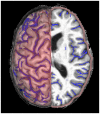Cortical gyrification and sulcal spans in early stage Alzheimer's disease
- PMID: 22363554
- PMCID: PMC3283590
- DOI: 10.1371/journal.pone.0031083
Cortical gyrification and sulcal spans in early stage Alzheimer's disease
Abstract
Alzheimer's disease (AD) is characterized by an insidious onset of progressive cerebral atrophy and cognitive decline. Previous research suggests that cortical folding and sulcal width are associated with cognitive function in elderly individuals, and the aim of the present study was to investigate these morphological measures in patients with AD. The sample contained 161 participants, comprising 80 normal controls, 57 patients with very mild AD, and 24 patients with mild AD. From 3D T1-weighted brain scans, automated methods were used to calculate an index of global cortex gyrification and the width of five individual sulci: superior frontal, intra-parietal, superior temporal, central, and Sylvian fissure. We found that global cortex gyrification decreased with increasing severity of AD, and that the width of all individual sulci investigated other than the intra-parietal sulcus was greater in patients with mild AD than in controls. We also found that cognitive functioning, as assessed by Mini-Mental State Examination (MMSE) scores, decreased as global cortex gyrification decreased. MMSE scores also decreased in association with a widening of all individual sulci investigated other than the intra-parietal sulcus. The results suggest that abnormalities of global cortex gyrification and regional sulcal span are characteristic of patients with even very mild AD, and could thus facilitate the early diagnosis of this condition.
Conflict of interest statement
Figures


Similar articles
-
Identification of Early-Stage Alzheimer's Disease Using Sulcal Morphology and Other Common Neuroimaging Indices.PLoS One. 2017 Jan 27;12(1):e0170875. doi: 10.1371/journal.pone.0170875. eCollection 2017. PLoS One. 2017. PMID: 28129351 Free PMC article.
-
Sulcal variability in the Alzheimer's brain: correlations with cognition.Neurology. 1998 Jan;50(1):145-51. doi: 10.1212/wnl.50.1.145. Neurology. 1998. PMID: 9443471
-
Cortical variability and asymmetry in normal aging and Alzheimer's disease.Cereb Cortex. 1998 Sep;8(6):492-509. doi: 10.1093/cercor/8.6.492. Cereb Cortex. 1998. PMID: 9758213
-
The relationship between cortical sulcal variability and cognitive performance in the elderly.Neuroimage. 2011 Jun 1;56(3):865-73. doi: 10.1016/j.neuroimage.2011.03.015. Epub 2011 Mar 21. Neuroimage. 2011. PMID: 21397704
-
Computational models of cortical folding: A review of common approaches.J Biomech. 2022 Jun;139:110851. doi: 10.1016/j.jbiomech.2021.110851. Epub 2021 Nov 9. J Biomech. 2022. PMID: 34802706 Review.
Cited by
-
Altered cortical and subcortical morphometric features and asymmetries in the subjective cognitive decline and mild cognitive impairment.Front Neurol. 2023 Dec 1;14:1297028. doi: 10.3389/fneur.2023.1297028. eCollection 2023. Front Neurol. 2023. PMID: 38107635 Free PMC article.
-
Predicting long-term progression of Alzheimer's disease using a multimodal deep learning model incorporating interaction effects.J Transl Med. 2024 Mar 11;22(1):265. doi: 10.1186/s12967-024-05025-w. J Transl Med. 2024. PMID: 38468358 Free PMC article.
-
Hierarchical multi-class Alzheimer's disease diagnostic framework using imaging and clinical features.Front Aging Neurosci. 2022 Aug 10;14:935055. doi: 10.3389/fnagi.2022.935055. eCollection 2022. Front Aging Neurosci. 2022. PMID: 36034132 Free PMC article.
-
Surface-based correlates of cognition along the Alzheimer's continuum in a memory clinic population.Front Neurol. 2023 Sep 5;14:1214083. doi: 10.3389/fneur.2023.1214083. eCollection 2023. Front Neurol. 2023. PMID: 37731852 Free PMC article.
-
Decreased Cortical Thickness and Local Gyrification in Individuals with Subjective Cognitive Impairment.Clin Psychopharmacol Neurosci. 2021 Nov 30;19(4):640-652. doi: 10.9758/cpn.2021.19.4.640. Clin Psychopharmacol Neurosci. 2021. PMID: 34690119 Free PMC article.
References
-
- Braak H, Braak E. Evolution of the neuropathology of Alzheimer's disease. Acta Neurol Scand Suppl. 1996;165:3–12. - PubMed
-
- Arnold SE, Hyman BT, Flory J, Damasio AR, Van Hoesen GW. The topographical and neuroanatomical distribution of neurofibrillary tangles and neuritic plaques in the cerebral cortex of patients with Alzheimer's disease. Cereb Cortex. 1991;1:103–116. - PubMed
-
- Morrison JH, Hof PR. Selective vulnerability of corticocortical and hippocampal circuits in aging and Alzheimer's disease. Prog Brain Res. 2002;136:467–486. - PubMed
-
- He Y, Wang L, Zang Y, Tian L, Zhang X, et al. Regional coherence changes in the early stages of Alzheimer's disease: a combined structural and resting-state functional MRI study. Neuroimage. 2007;35:488–500. - PubMed
Publication types
MeSH terms
LinkOut - more resources
Full Text Sources
Medical

